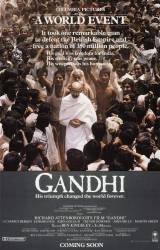Factual error: Jan Christiaan Smuts is referred to as the Prime Minister of the Union of South Africa in this film when Gandhi is there. Smuts didn't gain the office until 1919, after the death of Prime Minister Louis Botha. Gandhi left South Africa in 1914 and never returned.

Gandhi (1982)
Directed by: Richard Attenborough
Starring: Ben Kingsley, Candice Bergen, Edward Fox, John Gielgud, Rohini Hattangadi, Roshan Seth
Continuity mistake: The woman reporter was walking behind Gandhi at the beginning of the movie. At the end, in the "repeat," she wasn't.
Factual error: During the scenes of the Calcutta riots and various other places, we see various cars from the 50's when the events in question took place in the 40's. Most notably several Morris cars which hadn't been built yet.
Trivia: Ben Kingsley was offered the title role only after Alec Guinness and Anthony Hopkins turned it down.
Brigadier: You don't think we're just going to walk out of India.
Gandhi: Yes. In the end, you will walk out. Because 100,000 Englishmen simply cannot control 350 million Indians, if those Indians refuse to cooperate.
Gandhi: You're a temptress.
Margaret Bourke-White: Just an admirer.
Gandhi: Nothing is more dangerous, especially for an old man.
Gandhi: An eye for an eye only ends up making the whole world blind.
Question: What reason did the British general give for having opened fire on the unarmed crowd?
Join the mailing list
Separate from membership, this is to get updates about mistakes in recent releases. Addresses are not passed on to any third party, and are used solely for direct communication from this site. You can unsubscribe at any time.
Check out the mistake & trivia books, on Kindle and in paperback.




Answer: Brigadier-General Reginald Dyer has said his intent "was not to disperse the meeting but to punish the Indians for disobedience." Earlier that day, Dyer has banned all meetings to avoid any insurrection, but many still gathered to celebrate and protest. Dyer saw it as defiance of his order and thought it could be another mob insurgent he had seen earlier. Some reports also state while the crowd was "unarmed", that only referred to being unarmed with firearms and many in the crowd did have other types of weapons. It also seems at the time it was standard practice for the British Army to use necessary lethal force for civilian crowd control, although many saw Dyer's action to be in excess.
Bishop73